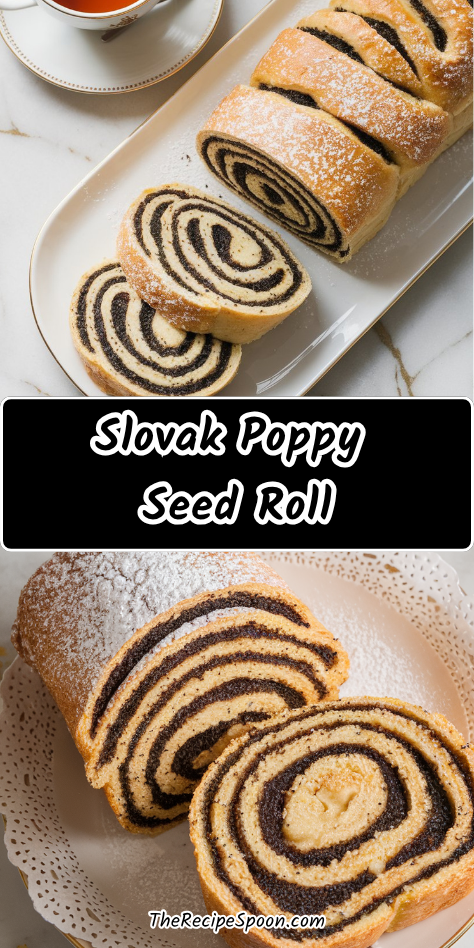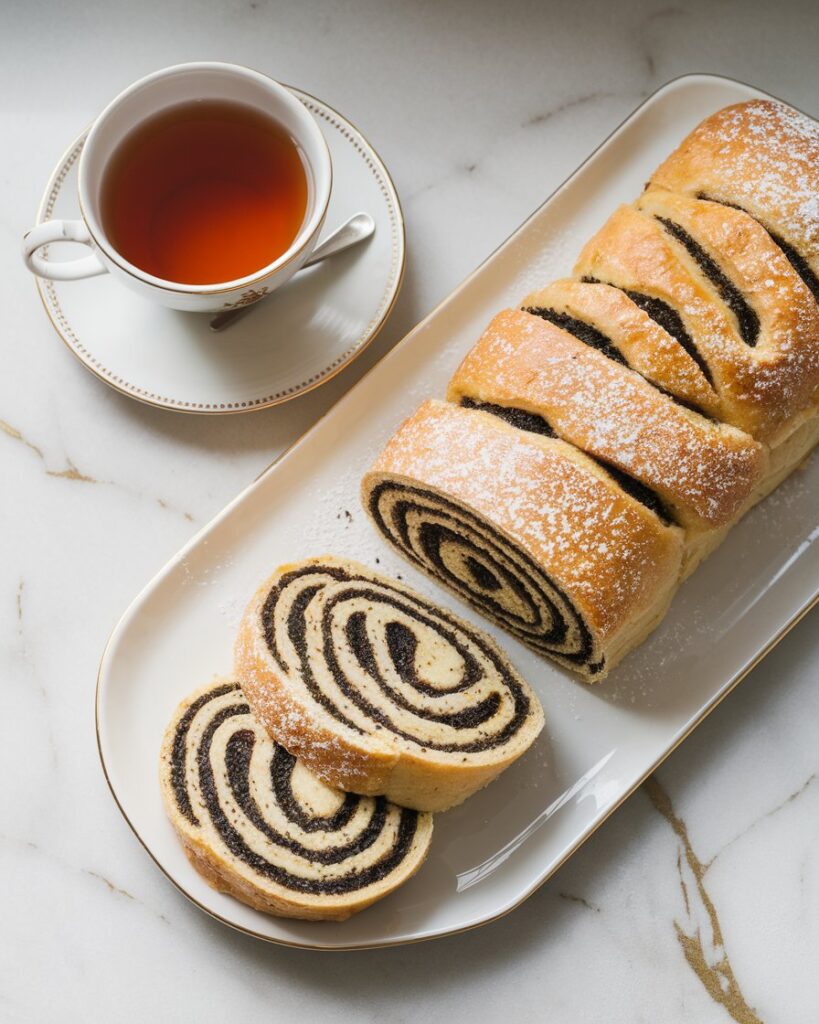There’s something truly special about traditional holiday baking, and Slovak Poppy Seed Roll, or Makovník, holds a treasured place in many Eastern European families.
With its delicate sweet dough wrapped around a generous poppy seed filling, this pastry is a symbol of comfort, celebration, and the warmth of a family kitchen.
Whether it’s served at Christmas, Easter, or Sunday coffee time, the scent of one baking in the oven brings back memories of grandmothers, hand-me-down recipes, and holidays spent around a full table.
Makovník is more than just a roll — it’s a work of love. The slightly sweet yeast dough is rolled thin and spread with a rich, slightly spiced poppy seed paste made with ground seeds, milk, sugar, and lemon zest.

As it bakes, the swirl pattern forms inside, giving you beautiful slices that are as lovely to look at as they are to eat.
Why You’ll Love This Recipe
This recipe captures the traditional flavor of Slovak Makovník with ingredients you can easily find. The dough is pillowy and soft, while the filling is earthy, nutty, and just sweet enough.
It’s ideal for make-ahead baking and perfect for gifting, serving at brunch, or enjoying with a warm cup of tea. Plus, it freezes well, so you can always have a taste of home ready to go.
What You’ll Need
For the Dough:
- 3 cups all-purpose flour
- 1 packet (2 ¼ teaspoons) active dry yeast
- ¾ cup warm milk (110°F)
- ¼ cup granulated sugar
- ¼ cup unsalted butter, softened
- 1 large egg
- ½ teaspoon salt
- ½ teaspoon vanilla extract
For the Poppy Seed Filling:
- 1 ½ cups ground poppy seeds
- ½ cup whole milk
- ½ cup granulated sugar
- 1 tablespoon honey
- 1 tablespoon unsalted butter
- Zest of 1 lemon
- ½ teaspoon cinnamon (optional)
For the Egg Wash:
- 1 egg yolk
- 1 tablespoon milk
Pro Tips
- Use finely ground poppy seeds – This gives the filling a smoother texture and prevents bitterness.
- Let the dough rise fully – Don’t rush it; the dough should double in size before rolling.
- Roll tightly but not too thin – Aim for ¼ inch thickness so the roll holds its shape without bursting.
- Seal the edges well – Pinch the seams closed and place the seam-side down to prevent leakage during baking.
- Cool completely before slicing – This helps the roll set and avoids crumbling.
Tools Required
- Stand mixer with dough hook (or mixing bowl and wooden spoon)
- Small saucepan
- Rolling pin
- Pastry brush
- Baking sheet
- Parchment paper
- Clean kitchen towel
- Microplane or grater (for zesting)
Substitutions and Variations
- Poppy seed prep: If you can’t find pre-ground poppy seeds, grind them in a spice grinder or use a food processor.
- Flavor variations: Add raisins or chopped nuts to the filling for extra texture.
- Glaze alternative: Instead of egg wash, brush with melted butter after baking for a softer finish.
- Sweet dough shortcut: Use store-bought refrigerated yeast dough in a pinch (though homemade is always best).
- Nut roll alternative: Use a ground walnut filling for another popular Slovak version.

Make-Ahead Tips
You can prepare the dough and poppy seed filling up to a day in advance. Store the dough tightly wrapped in the refrigerator and bring to room temperature before rolling.
The baked roll also freezes beautifully. Let it cool fully, then wrap tightly in plastic and foil. Freeze for up to 2 months.
Instructions
1. Make the dough
In a small bowl, dissolve yeast in warm milk with 1 teaspoon of sugar. Let sit 5–10 minutes until foamy. In a mixing bowl, combine flour, remaining sugar, salt, and vanilla. Add yeast mixture, softened butter, and egg. Knead for 8–10 minutes until smooth and elastic. Cover and let rise in a warm place until doubled, about 1 to 1½ hours.
2. Prepare the poppy seed filling
In a small saucepan, combine milk, sugar, honey, and butter. Bring to a simmer. Stir in ground poppy seeds, lemon zest, and cinnamon. Cook for 3–5 minutes, stirring until thickened. Let cool completely before spreading.
3. Roll out the dough
Punch down the risen dough and roll it into a rectangle approximately 12×15 inches on a lightly floured surface. Spread the cooled poppy seed filling evenly over the dough, leaving a ½-inch border.
4. Roll and shape
Starting from the longer side, roll the dough tightly into a log. Pinch the seam and ends closed. Place seam-side down on a parchment-lined baking sheet. Cover with a towel and let rise again for 30–45 minutes.
5. Brush and bake
Preheat oven to 350°F. Brush the roll with egg wash. Bake for 30–35 minutes, or until golden brown and hollow-sounding when tapped. Tent with foil if browning too quickly.
6. Cool and slice
Remove from oven and let cool completely on a wire rack. Slice gently with a serrated knife to serve.
Leftovers and Storage
Store leftovers wrapped tightly in foil or plastic wrap at room temperature for up to 3 days. For longer storage, refrigerate for up to a week or freeze for up to 2 months. To serve, reheat slices gently in the microwave or toast oven for a just-baked feel.
Recipe FAQ
1. Can I use canned poppy seed filling?
Yes, you can use canned filling as a shortcut. It may be sweeter, so adjust to taste.
2. Why is my roll cracking on top?
Over-proofing or rolling too tightly can cause cracks. Letting the dough rest between steps helps.
3. Can I double the recipe?
Yes, this recipe doubles well. Bake two smaller rolls or one extra-large loaf.
4. Is this the same as Hungarian beigli?
Very similar! Many Central European countries have versions of poppy seed roll — ingredients and proportions may vary slightly.
A Taste of Tradition
There’s something incredibly rewarding about baking a Slovak poppy seed roll from scratch. From the rich aroma of the filling to the soft dough and beautiful spiral slices, this recipe brings Old World comfort straight into your modern kitchen. Whether you’re honoring a family tradition or discovering it for the first time, this roll offers a beautiful, meaningful treat that’s worth every step.
Have you made Makovník before? Leave a comment and share your memories, tips, or how your family makes it special. I’d love to hear how this beloved pastry finds its way onto your table.